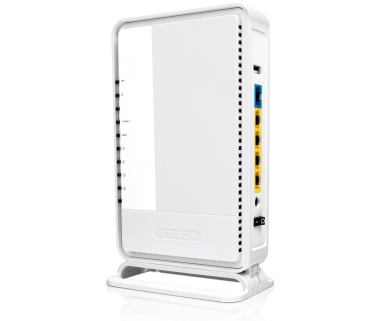Stap-voor-stap installatie van je router
1: Inhoud

Elke router wordt geleverd met een netwerk kabel (1 meter) en een stroom adapter.
Daarnaast vind je in elke doos:
- Installatie CD Router USB Software. Deze CD heb je alleen nodig als je een USB apparaat met je router wilt verbinden.
- Installatiegids.
- Netwerk login details (bewaar deze goed!).
- Sitecom Cloud Security informatie gids (Alleen bij routers met deze functionaliteit).
- CE compliance document.
Verbind de router met je modem
Volg onderstaande stappen (2 t/m 4) om je router correct met je modem te verbinden.
2: Modem van het stroomnetwerk halen
- Verwijder de stroomadapter van de modem uit het stopcontact. Zodoende wordt de modem gerest en krijgt de router na aansluiten altijd toegang tot de modem.
- Sluit de stroomadapter van de router aan op de router.

Verbind de router met je modem
3: Router aansluiten op de modem
- Sluit de router aan op de modem via de netwerkkabel (UTP kabel). Gebruik op de modem de LAN poort en op de router de WAN poort. Doe dit terwijl de modem en router NIET aangesloten zijn op het stroomnetwerk.
- Sluit de modem weer aan op het stroomnetwerk. Wacht een paar minuten tot de modem weer geheel is opgestart.

Verbind de router met je modem
4: Router aansluiten op stroomnetwerk
- Sluit nu de router aan op het stroomnetwerk.
- Zet de router aan door de aan/uit knop op “I” te zetten.
- Wacht 2 minuten. De modem stuurt nu een toegangsadres (IP adres) naar de router waarmee de router toegang krijgt tot het internet.

Verbind de router met uw PC / Mac
Volg nu onderstaande stappen (5 t/m 9) om je Windows of Mac PC met je router te verbinden.
5: Beschikbare draadloze netwerken tonen.
Beschikbare draadloze netwerken tonen (PC)
- Dubbelklik op het icoontje voor draadloze netwerken aan de rechter onderzijde van de werkbalk.
Beschikbare draadloze netwerken tonen (Mac)
- Dubbelklik op het icoontje voor draadloze netwerken in de rechterbovenzijde van de werkbalk.

Verbind de router met uw PC / Mac
6: Draadloos netwerk kiezen
- Zoek aan de onderzijde van uw router of in de ‘network login details flyer’ naar de naam van het netwerk van de router.
- Selecteer het netwerk uit de lijst beschikbare netwerken door op het netwerk te klikken.


- Ga verder naar stap 2C: Invoeren beveiligingssleutel.
Verbind de router met uw PC / Mac
7: Invoeren beveiligingssleutel (Windows)
- Voer het WPA2 password in dat vermeldt staat op de onderzijde van de router of de ‘network login details flyer’ in het veld bij “Security Key”.
- Klik vervolgens op ‘Ok’.
- De router gaat nu een beveiligde verbinding maken met de modem en het internet.

Verbind de router met uw PC / Mac
8: Invoeren beveiligingssleutel (Mac)
- Voer het WPA2 password in dat vermeldt staat op de onderzijde van de router of de ‘network login details flyer’ in het veld bij “Password”.
- Klik vervolgens op ‘Join’.
- De router gaat nu een beveiligde verbinding maken met de modem en het internet.

Verbind de router met uw PC / Mac
9: Controleer draadloze verbinding
Windows PC
- Wanneer je verbinding hebt met de router, dan zullen de 5 balken wit kleuren en zal de gele ster zijn verdwenen. Je kan nu draadloos internetten.
Mac
- Wanneer je verbinding hebt met de router, dan zal het icoontje dat het draadloos internet signaal aangeeft zwart kleuren. Je kunt nu draadloos internetten.

Klaar! Je hebt nu een werkende internetverbinding
10: Je router is klaar!














